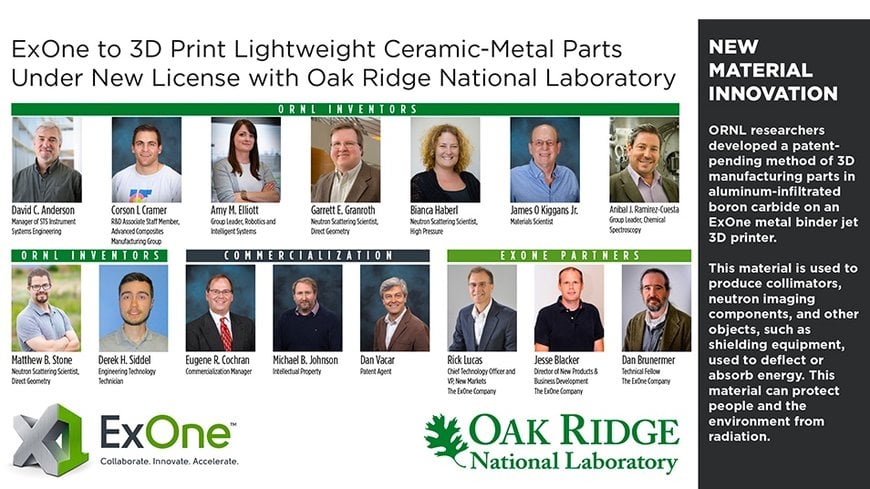www.industryemea.com
27
'21
Written on Modified on
ExOne to 3D Print Lightweight Ceramic-Metal Parts Under New License With Oak Ridge National Laboratory
ExOne has reached a commercial license agreement with the U.S. Department of Energy’s Oak Ridge National Laboratory to 3D print parts in aluminum-infiltrated boron carbide (B4C).

The ExOne Company (Nasdaq: XONE), the global leader in industrial sand and metal 3D printers using binder jetting technology, today announced it has reached a commercial license agreement with the U.S. Department of Energy’s Oak Ridge National Laboratory to 3D print parts in aluminum-infiltrated boron carbide (B4C).
Researchers at ORNL developed the patent-pending method of 3D printing aluminum-infiltrated B4C on an ExOne M-Flex, a 3D printer that uses binder jetting technology to 3D print objects in metals, ceramics and other powder materials.
In 2019, ExOne executed an R&D license for the manufacturing process. Now, that license has been expanded to commercial use so that ExOne can begin printing aluminum-infiltrated B4C collimators, shielding equipment, and other components used in neutron scattering research.
ExOne Technology Drives ORNL Innovation
Binder jetting is a groundbreaking 3D printing process that uses a digital file to quickly inkjet a binder into a bed of powder particles — metal, sand or ceramic — creating a solid part one layer at a time. When printing metals, the final part may be fabricated into a solid object. Other materials can also be infiltrated into the part during this process.
In this instance, a team at ORNL led by David C. Anderson, Manager of Instrument Systems Engineering for the Second Target Station Project, developed a process to 3D print objects in B4C, a neutron-absorbing material, and then infiltrate the objects with aluminum. Infiltration is when a material is wetted or absorbed into another material like water into a sponge. The final aluminum-infiltrated B4C material is known as a metal-matrix composite, a type of cermet. ORNL’s Amy Elliott is a co-inventor of this process. Additional co-inventors of these technologies include Corson Cramer and Bianca Haberl, both of ORNL.
The development is significant because aluminum-infused B4C has strong but lightweight properties, as well as neutron-absorbing characteristics that are particularly useful in neutron scattering instruments, which enable researchers to capture data down to the atomic level.
Using traditional methods, manufacturers face limitations in the shapes of collimators they can produce, which also limits the type of research and other work that could be done with them. The new method of creating B4C objects opens the door to new types of objects useful in deflecting or absorbing energy, which can protect people and the environment from radiation.
The intellectual property covered in the license agreement includes pending U.S. patent application no. 16/155,134, entitled “Collimators and Other Components from Neutron Absorbing Materials Using Additive Manufacturing,” as well as two additional provisional filings. Under the agreement, ExOne will also engage in ongoing 3D printing production of a variety of B4C matrix components used in neutron scattering experiments at ORNL.
The new B4C material also means that ExOne can now offer its customers a method of 3D printing a metal material that is lighter than bronze. ExOne’s metal 3D printers, such as the Innovent+®, M-Flex®, X1 25Pro®, and X1 160Proare capable of 3D printing objects more than 22 materials today.
ORNL is managed by UT-Battelle for the U.S. Department of Energy's Office of Science, the single largest supporter of basic research in the physical sciences in the United States. DOE’s Office of Science is working to address some of the most pressing challenges of our time.
www.exone.com

